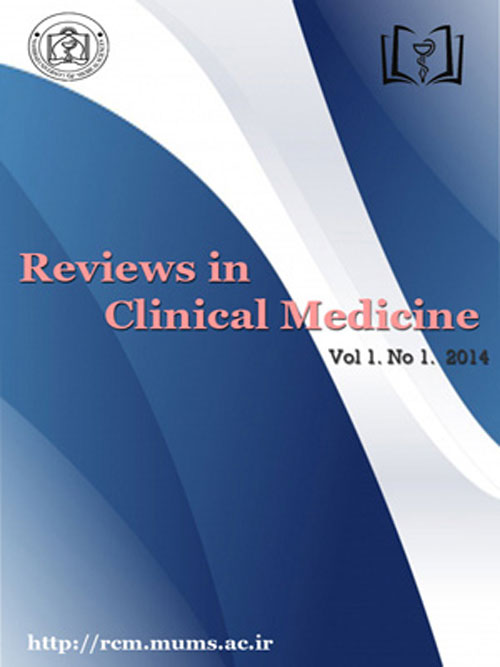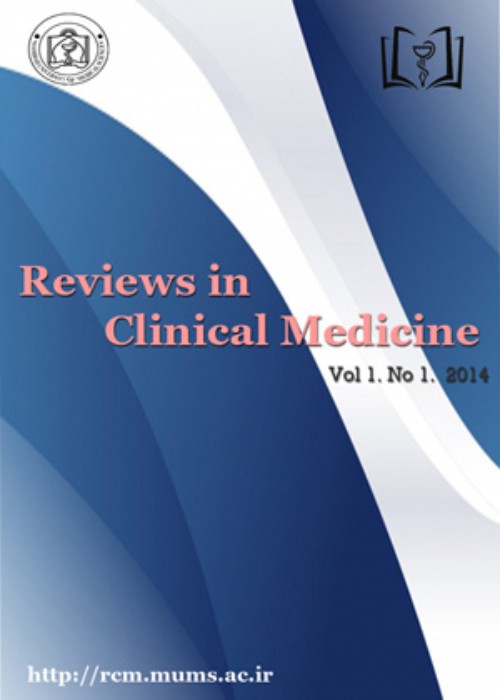فهرست مطالب

Reviews in Clinical Medicine
Volume:4 Issue: 3, Summer 2017
- تاریخ انتشار: 1396/07/02
- تعداد عناوین: 8
-
Pages 87-96IntroductionThis article aimed to review the literatures on visual impairments and ocular changes in premature infants with low birth weight and gestational age.MethodsFive electronic databases including: PubMed, Web of Science, Science direct, Ovid, and Scopus were searched. Original articles published until 2015 describing preterm infants were reviewed. Repetitive and derivative articles were excluded.ResultsOut of 100 unique, potentially relevant articles, 42 studies that addressed and met the inclusion criteria were evaluated.ConclusionPrematurity affects ocular structures (from anterior to posterior segment) and functions. Premature infants are at risk of myopization. Concerning the changes in premature infants, a significant increase is found in axial length, intraocular pressure, and central corneal thickness; moreover, high incidence of retinal changes is reported as a result of prematurity. On the other hand, visual acuity, tear, electroretinogram, and visual evoked potential responses decrease with prematurity. The most common ophthalmic disorders in preterm infants are myopia and retinopathy of prematurity, which could affect life quality due to reduced visual acuity.Keywords: Prematurity, premature infants, Preterm infants
-
Pages 97-101IntroductionThe pathophysiology of ischemia involves the cellular effect of myocardial ischemia, reactive oxygen species, and reactive inflammatory enzymes. Left atrial (LA) ischemia has been shown to have several mechanisms through which it can lead to abnormalities in left ventricular filling in early diastole and thus reduces LA passive functional reserve. In this review, we evaluated the physiological mechanisms of LA during myocardial ischemia, as previously demonstrated in experimental and clinical studies.MethodsSeveral databases were searched in order to find related articles. The outcome of interest included LA function measurements (measurement of LA volume) during ischemia. By applying a standardized protocol, reviewers independently extracted and assessed the studies.ResultsThe literature review indicated 50 publications, among which 15 studies were eligible for analysis. Assessment of LA dimension and function is essential for clinical evaluation and prognostic purposes.ConclusionThe present article revealed that LA passive emptying volume and LA emptying volume significantly increased in myocardial ischemia. Further researches could provide a better understanding of pathophysiological mechanisms behind LA enlargement and help to predict clinical outcomes in many cardiovascular disorders.Keywords: Cardiac volume, Left Atrial Functions, Myocardial ischemia
-
Blood loss prevention in total knee arthroplasty (TKA):a systematic reviewPages 102-123IntroductionThis exhaustive literature review aimed to find articles in relation to blood loss prevention in TKA via searching in databases such as PubMed and Google Scholar during 2005-2015.MethodsIn this study, we included all the articles focusing on the evaluation of blood loss during TKA using specific treatment methods to reduce blood loss. We explored the studies with control groups and placebo subjects, and other studies were excluded from this review. The obtained results of each surveyed articles were summarized and evaluated based on the objectives of this study.ResultsIn total, 68 studies performed on 8,355 patients were included in this review, 18 of which were double-blinded, and 40 were open-label. A significant difference was observed in the transfusion thresholds of all the reviewed studies. According to our findings, frequency of prophylactic deep venous thrombosis (DVT) varied in the reviewed studies due to the use of different techniques to prevent blood loss after TKA; the incidence of DVT was reported in 15 articles.ConclusionSince ABT involves high risks and even morbidity, new techniques should be applied to prevent blood loss. Although several techniques are available to reduce blood loss in TKA, ABT is frequently practiced and might lead to anemia in TKA patients. On the other hand, the effectiveness of new methods used to prevent blood loss remains a matter of question since all these methods are associated with certain adverse side effects.Keywords: Arthritis, Blood transfusion, Knee arthroplasty
-
Pages 124-127Anthropometry is a science of human body measurement that could be used for manufacturing artificial limbs or prosthesis, investigating body differences between populations, utilizing in forensics and criminology, or even in the diagnosis of some diseases. Two of the most important anthropometric characteristics are dermatoglyphic patterns and finger length. Many studies have evaluated the relation between these two characteristics in different diseases such as cancers. It assumed that dermatoglyphic patterns and finger length could be used as predictors of some cancers such as gastric, ovarian, prostate, testicular, and breast cancers. In this review, we evaluated the relation between dermatoglyphic variability and finger length in different cancers more precisely.Keywords: Anthropometry, Finger length ratio (2D:4D), Gastric cancer
-
Pages 128-130World Health Organization (WHO) estimates that the number of people with diabetes will grow 114% by 2030. It declares that patients themselves have more responsibility for controlling and the treatment of diabetes by being provided with updated knowledge about the disease and different aspects of available treatments, and diet therapy in particular. In this regard, diet recommendation systems would be helpful. They are techniques and tools which suggest the best diets according to patients health situation and preferences. Accordingly, this narrative review studied food recommendation systems and their features by focusing on nutrition and diabetic issues. Literature searches in Google scholar and Pubmed were conducted in February 2015. Records were limited to papers in English language; however, no limitations were applied for the published date. We recognized three common methods for food recommender system: collaborative filtering recommender system (CFRS), knowledge based recommender system (KBRS) and context-aware recommender system (CARS). Also wellness recommender systems are a subfield of food recommender systems, which help users to find and adapt suitable personalized wellness treatments based on their individual needs. Food recommender systems often used artificial intelligence and semantic web techniques. Some used the combination of both techniques.Keywords: Diabetes, Food recommender system, Diet therapy
-
Pages 131-135Nearly 70 million people worldwide suffer from epilepsy. Despite administration of routine antiepileptic drugs (AEDs), nearly 30% of seizures are resistant to treatment called drug resistant epilepsy (DRE). Since the epilepsy treatment may result in consequences of multi-drugs administration or sometimes invasive surgical methods in DRE, herbal treatment can be a good alternative choice due to its easy accessibility, lower cost and fewer side effects. Although turmeric has been one of a very commonly used dietary spices and traditional herbal remedies, its derivation as a newly introduced medicine-curcumin has not been used to a large extent. In this literature, we have reviewed the available trial researches, which studied specifically antiepileptic effect of curcumin. We searched databases of Science direct, PubMed and Google Scholar (2008 to 2016) with key words of turmeric, curcumin, Diferuloylmethane, Epilepsy, and Seizure to find the related references. The major extract of turmeric curcumin has found to have antiepileptic effect according to recent surveys. It not only has no critical adverse effect, but also can protect patients from other AEDs severe side effects. It also makes it possible to gradually decrease the dose of AEDs in long-term combination therapy.Keywords: curcumin, Diferuloylmethane, Epilepsy, Seizure, Turmeric
-
Pages 136-139Air pollution consists of chemicals resulting from many human activities and natural resources, which can cause gene mutations. Almost, it is proven that air pollution contributes to lung cancer and its relationship with other cancers including bladder, cervical cancer, ovary, prostate, brain and breast cancer is suspected. Breast cancer is the most frequent cancer in women and the prominent cause of death among them all around the world. Poor prediction of risk factor leads to discovery of more reliable factors. Mammary tumors in animals that are generated by chemicals compounds, give possible mechanisms for effects of environmental pollutants. Therefore, the purpose of our study is to review the available literature for investigating the relation of ambient air pollution and breast cancer. Findings of our study highlight the possibility of increasing in occurrence of breast cancer, developing to invasive cancer and mortality in both premenopausal and postmenopausal women exposed to air pollution.Keywords: Air Pollution, Breast Cancer, Risk factor
-
Pages 140-142Postpartum hemorrhage (PPH) is one of the most common complications of delivery and is a major cause of maternal morbidity and mortality. The aim of this report is to introduce a case of therapeutic uterine artery embolization (UAE) in a life-threatening postpartum hemorrhage.
A 26-year old G3P3 woman with severe postpartum hemorrhage after 50 days of delivery referred to the emergency unit of an academic hospital of Mashhad University of Medical Sciences, Iran with third episode of vaginal bleeding. Gynecological examination and sonography were completely normal. Hypovolemic shock that was managed by fluid and blood replacement-therapy with uterotonic medical agents including oxytocin infusion (40 unit/lit), injection of 0.2 mg methyl-ergonovin and 1000 µg rectal misoprostol. Uterine artery embolization was planned due to unremitting severe hemorrhage. Embolization resulted in successful control of hemorrhage and the patient was discharged. At 6 months follow-up, no adverse events pertinent to embolization were noted. Therefore, UAE is suggested as a useful method for controlling intractable bleeding due to postpartum hemorrhage.Keywords: Angiography, Postpartum hemorrhage, Uterine artery embolization


